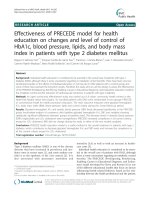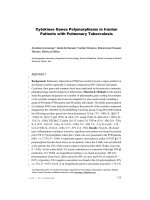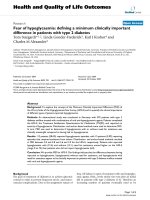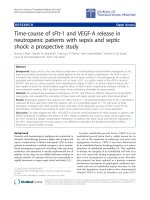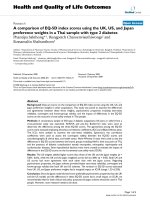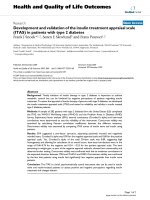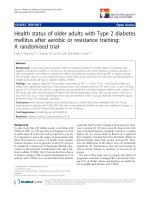Distribution of cytotoxic T lymphocyte-associated antigen-4 promoter polymorphisms in Taiwanese patients with type 2 diabetes mellitus
Bạn đang xem bản rút gọn của tài liệu. Xem và tải ngay bản đầy đủ của tài liệu tại đây (384.26 KB, 8 trang )
Int. J. Med. Sci. 2018, Vol. 15
Ivyspring
International Publisher
395
International Journal of Medical Sciences
2018; 15(4): 395-402. doi: 10.7150/ijms.23097
Research Paper
Distribution of Cytotoxic T Lymphocyte-Associated
Antigen-4 Promoter Polymorphisms in Taiwanese Patients
with Type 2 Diabetes Mellitus
Yung-Luen Shih1,2,3†, Hsu-Feng Lu4†, Chiao-Wan Hsiao5,6*, Kuo-Ting Ho6,7*, Pei-Chi Chen8, Chien-Ning
Huang9,10, Yuanmay Chang11, Shang-Jyh Kao12, Ming-Yuh Shiau13 and Yih-Hsin Chang6
1.
2.
3.
4.
5.
6.
7.
8.
9.
10.
11.
12.
13.
†
Department of Pathology and Laboratory Medicine, Shin Kong Wu Ho-Su Memorial Hospital, Taipei,
School of Medical Laboratory Science and Biotechnology, Taipei Medical University, Taipei,
School of Medicine, College of Medicine, Fu-Jen Catholic University, New Taipei City,
Department of Clinical Pathology, Cheng Hsin General Hospital, Taipei,
Program in Molecular Medicine, National Yang-Ming University and Academia Sinica, Taipei,
Department of Biotechnology and Laboratory Science in Medicine, National Yang-Ming University, Taipei,
Hi-Q Clinical Laboratory, Quanzhou, Fujian Province, PRC,
Divisions of Endocrinology and Metabolism, Shin Kong Wu Ho-Su Memorial Hospital, Taipei,
Department of Internal Medicine, Chung Shan Medical University Hospital, Taichung,
School of Medicine, Chung Shan Medical University, Taichung,
Department of Long Term Care, MacKay Medical College, New Taipei City,
Pulmonary Division, Shin Kong Wu Ho-Su Memorial Hospital, Taipei,
Department of Nursing, College of Nursing, Hungkuang University, Taichung, Taiwan
Equal contributions as the 1st authors
* Equal contributions as the 3rd authors
Corresponding authors: Ming-Yuh Shiau, PhD, Associate Professor, Department of Nursing, College of Nursing, Hungkuang University, Taichung 433,
Taiwan. Tel: 886-4-26318652 ext. 7090; Fax: 886-4-26311198; E-mail: Yih-Hsin Chang, PhD, Professor, Department of Biotechnology and
Laboratory Science in Medicine, National Yang-Ming University, Taipei 112, Taiwan. Tel: 886-2-28267955; Fax: 886-2-28219240; E-mail:
© Ivyspring International Publisher. This is an open access article distributed under the terms of the Creative Commons Attribution (CC BY-NC) license
( See for full terms and conditions.
Received: 2017.09.29; Accepted: 2018.01.05; Published: 2018.02.12
Abstract
Type 2 diabetes mellitus (T2DM) is associated with chronic inflammation, suggesting the metabolic
abnormalities are originated from or exacerbated by cytokine overproduction. Cytokines and
counter-regulatory molecules are crucial in keeping the balance of immune responses and, therefore, are
potential candidates involved in T2DM etiology, development and complications. Our previous reports
identify several significant associations between the genotypes of cytokine genes and T2DM and/or the
clinical lipid parameters, which strongly suggest the participation of immune-regulatory molecules in lipid
metabolism. The aim of this study is to determine the distribution of gene encoding cytotoxic T
lymphocyte-associated antigen-4 (CTLA-4), a T-cell negative regulator, in T2DM patients and health
subjects. Genomic DNA was extracted from 287 Taiwanese T2DM patients and 278 ethnic- and agematched healthy subjects, and two CTLA-4 polymorphisms (-318 C/T and +49 A/G) were analyzed by
polymerase chain reaction-restriction fragment length polymorphism. Intriguingly, CTLA-4 -318 genotype
was associated with circulatory triglycerides in T2DM subjects (P=0.019) although no significant
association between CTLA-4 -318 (P=0.119) and +49 (P=0.2) genotypes with T2DM was identified. In
addition, CTLA-4 +49 genotype was significantly associated with the ratio between total cholesterol and
high-density lipoprotein (P=0.004) in control subjects. Our results suggest that CTLA-4 may be involved
in lipid metabolism and affect T2DM disease progression and/or the development of diabetic
complications although this gene does not represent a major risk factor for T2DM.
Key words: type 2 diabetes mellitus; cytotoxic T lymphocyte-associated antigen-4; genetic polymorphisms
Introduction
Type 2 diabetes mellitus (T2DM) is the most
common form of diabetes characterized by
abnormally high blood glucose. People with risk
factors such as dyslipidemia, impaired glucose
Int. J. Med. Sci. 2018, Vol. 15
tolerance, and hypertension (so-called metabolic
syndrome) are susceptible to develop T2DM. The
global prevalence of diabetes is estimated to reach
4.4% with more than 350 million affected people in
year 2030 [1]. The prevalence of T2DM varies among
different ethnic populations, with the highest rate
found in Pima Indians (as high as ~50%) [2]. In
Taiwan, more than 98% of diabetic patients are
characterized as T2DM [3], affecting more than 1
million individuals.
The etiology of T2DM is still an enigma although
insulin resistance is the major characteristics. Genetic
and environmental factors are the study focus of
T2DM etiology, and linkage studies have localized
some of the genes that influence the development of
this disorder. Cytokines and counter-regulatory
molecules are crucial in the regulation of immune
responses and, therefore, are potential candidates
involved in T2DM etiology. Evidence regarding
cytokine gene polymorphisms among T2DM patients
is increasing, however, with conflicting and
inconclusive observations [4].
Cytotoxic T lymphocyte-associated antigen-4
(CTLA-4), a negative regulator of T cell activation and
proliferation, plays important roles in regulating
immune surveillance and responses [5]. Abundant
evidence has documented the association of several
single nucleotide polymorphisms (SNPs) of the
CTLA-4 gene and autoimmune diseases such as type 1
diabetes mellitus [6-10]. Nevertheless, the putative
association between CTLA-4 and the more prevalent
T2DM does not cause much attention. Only very
limited reports with contradictory conclusions
regarding the study of CTLA-4 and T2DM are
documented [11-14]. The discrepancy indicates that
unique genetic characteristics may be involved in
T2DM pathogenesis among different ethnic
population [15]. Therefore, it is tempting to identify
whether the CTLA-4 SNPs would contribute to T2DM
pathogenesis and/or clinical manifestations in
Taiwan. To inspect this hypothesis, the frequencies of
the CTLA-4 SNPs (-318C/T and +49A/G) among
patients with T2DM as well as the association of these
polymorphisms with patients’ biochemical features
were examined in Taiwanese population.
Materials & Methods
Study subjects
Whole blood samples of 278 Taiwanese patients
with T2DM were obtained from the Divisions of
Endocrinology and Metabolism and the Department
of Pathology and Laboratory Medicine, Shin Kong
Wu Ho-Su Memorial Hospital, Taipei. For reference,
control population consisted of 287 unrelated, ethnic-
396
and age- matched non-diabetic healthy subjects were
recruited from Shin Kong Wu Ho-Su Memorial
Hospital, Taipei, by selecting those with normal blood
glucose. The diagnosis of T2DM was based on the
clinical characteristics, magnitude of residual insulin
or C-peptide secretory responses. Information about
patients’ clinical biochemical manifestations were
listed in Table 1. Informed consent from each study
subject was obtained after the nature of study was
fully explained. The study was approved by the Ethics
Review Committee of Shin Kong Wu Ho-Su Memorial
Hospital.
Table 1. Demographic and biochemical data of study subjects in
this study
HbA1c (%)
Fasting glucose (70-110 mg/dL)*
ALT (<40 U/L)*
HDL-C (>35 mg/dL)*
LDL-C (<160 mg/dL)*
Triglycerides (20-200 mg/dL)*
Cholesterol (125-240 mg/dL)*
CHO/HDL
Creatinine (0.6-1.4 mg/dL)*
Control
(n=287)†
5.54±0.32
87.52±7.95
38.36±23.26
52.38±13.53
118.55±29.26
118.49±67.38
193.98±32.85
2.78±2.00
0.80±0.18
T2DM
(n=278)†
8.18±2.24
148.3±59.96
32.1±27.93
45.76±15.87
100.34±32.50
214.25±486.09
185.09±63.09
1.97±0.82
0.91±0.41
P†
<0.001
<0.001
<0.001
<0.001
<0.001
<0.001
<0.001
<0.001
0.016
Data were presented as mean ± standard deviation.
*Numbers in parenthesis indicated the normal reference range of each biochemical
test.
†Mann-Whitney test.
Biochemical analysis
Serum samples from the study subjects were
isolated and subjected to analysis by automated
biochemical analyzers, including fasting glucose,
cholesterol (CHO), triglycerides (TGs), high density
lipoprotein (HDL), low-density lipoprotein (LDL),
creatinine, alanine aminotransferase (ALT) [by
AU680/AU5800, Beckman Coulter, USA] and
glycosylated hemoglobin HbA1c [by HLC-723 G8,
Tosoh, Japan]. CHO/HDL was calculated and
documented as ratio by levels of CHO over HDL.
CLTA-4 genotyping
CTLA-4 genotyping were conducted as
described [16]. Genomic DNA was extracted from
peripheral blood mononuclear cells using GenoMaker
commercial kit (GenePure Technology, Taiwan).
Amplification of +49 and -318 fragments was
performed in a volume of 30 μL containing 100 ng of
template DNA, 10 mmol/L Tris-HCl (pH9.0), 50 mM
KCl, 3 mM MgCl2, 0.01% gelatin and 0.1% Triton
X-100, 50 μM dNTP, 0.5 μM of each primer (as listed
in Table 2) and 1 unit GeneTaq DNA polymerase
(GenePure Technology, Taiwan). The parameters for
thermocycling were as followings: an initial
denaturation at 95oC for 5 minutes, followed by 30
Int. J. Med. Sci. 2018, Vol. 15
397
cycles of denaturation at 95oC for 1 min; annealing at
55oC for 1 min; extension at 72oC for 1 min; and
followed by final extension at 72oC for 5 minutes.
Identification of the 2 alleles at +49 and -318
polymorphic sites was performed by incubating PCR
product with Bbv I and Mse I, respectively, followed
by electrophoresis.
Table 2. Primer sequences used for the detection of genetic
polymorphisms.
Genotypes Primer sequence
CTLA-4
-318C>T
+49A>G
Restriction PCR product
enzyme
(bps)
5’- AATGAATTGGACTGGATGG Mse I
-3’
5’-TTACGAGAAAGGAAGCCGTG
-3’
5’-CCACGGCTTCCTTTCTCGTA-3’ Bbv I
5’AGTCTCACTCACCTTTGCAG-3’
247
329
Statistical analysis
Data analysis started with descriptive statistics,
including mean and standard deviation for
continuous variables, and frequency for categorical
variables. If necessary, natural logarithm transformation was used to enhance normality for blood
biochemistry parameters with skewed distribution.
Mann-Whitney test was applied for comparisons of
each of the blood biochemistry parameters between
diabetic and controls subjects, and Chi-square test for
comparing frequencies of different genotypes and
alleles between groups. Moreover, student's t-test and
non-parametric Kruskal Wallis test were applied to
compare means of respective blood biochemistry
parameters among subjects with different CTLA-4
genotypes, respectively. The statistical software of
SPSS software was applied for the analyses. Statistical
differences were defined as P<0.05 for all statistical
tests.
Results
Distribution of CTLA-4 genotypes among the
study subjects
The present study aimed at investigating the
distribution of CTLA-4 genetic polymorphisms among
the healthy subjects and T2DM patients. Detail
information
about
the
clinical
biochemical
manifestations among the study subjects were listed
in Table 1. Significant differences of all the
biochemical data were identified between the control
and T2DM subjects.
Table 3 showed the distribution of CTLA-4
genotyping results among the study subjects. In
non-diabetic control individuals, 215 (74.9%), 67
(23.3%) and 5 (1.7%) carried CTLA-4 -318 C/C,
heterologous C/T and T/T genotype, respectively. In
T2DM patients, 227 (81.7%), 49 (17.9%) and 2 (0.7%)
carried C/C, C/T and T/T genotype, respectively.
The prevalence of -318*C and -318*T allele in control
individuals was 86.6% and 13.4%, respectively; and
the corresponding frequencies in T2DM patients was
90.3% and 9.7%. No significant difference of CTLA-4
-138 genotypic distribution between subject groups
was identified (P=0.119), while marginal significance
was observed in the CTLA-4 -318 allelic distribution
(P=0.063).
In terms of the CTLA-4 +49 polymorphisms
(Table 3), 36 (12.5%), 150 (52.3%) and 101 (35.3%)
control subjects carried A/A, heterologous A/G and
G/G genotype, respectively. In patients with T2DM,
33 (11.9%), 127 (45.7%) and 118 (42.4%) carried A/A,
A/G and G/G genotype, respectively. The prevalence
of +49*A and +49*G alleles in control individuals was
38.7% and 61.3%, respectively; and that in T2DM
counterpart was 34.7% and 65.3%. Neither the CTLA-4
+49 genotypic (P=0.2) nor allelic (P=0.175) distribution between subject groups showed significant
differences.
Table 3. Frequencies of genotypic polymorphisms in T2DM
patients and control subjects.
CTLA-4 -318C/T
C/C
C/T
T/T
C allele
T allele
Control
n (%)
n=287
215 (74.9)
67 (23.3)
5 (1.7)
497 (86.6)
77 (13.4)
T2DM
n (%)
n=278
227 (81.7)
49 (17.9)
2 (0.7)
502 (90.3)
54 (9.7)
CTLA-4 +49A/G
A/A
A/G
G/G
A allele
G allele
n=287
36 (12.5)
150 (52.3)
101 (35.2)
222 (38.7)
352 (61.3)
n=278
33 (11.9)
127 (45.7)
118 (42.4)
193 (34.7)
363 (65.3)
P† value
0.119
0.063
0.2
0.175
Number in the parentheses indicated the percentage.
Chi-square test.
*
†
Association of CTLA-4 genotypes with
triglycerides and the ratio of total cholesterol
to high-density lipoprotein cholesterol
The correlation between study subjects’
biochemical manifestations with their genotypes was
subsequently analyzed. For CTLA-4 -318 polymorphisms (Table 4), significant association between the
genotypes with TGs was identified in T2DM patients
(P=0.019). In addition, a tendency reaching significant
association between CTLA-4 -318 genotypes with
fasting glucose (P=0.069) and CHO/HDL (P=0.067)
was observed in control subjects. As for +49 SNPs
Int. J. Med. Sci. 2018, Vol. 15
398
(Table 5), significant association between genotypes
with the ratio of total CHO to HDL-C (CHO/HDL) was
identified in healthy subjects (P=0.004). Besides, marginal
significance between genotypes and ALT was noticed
(P=0.063). Nevertheless, no significant association
between +49 genotypes and the biochemical parameters in the T2DM patients was found.
Table 4. Associations between CTLA-4 -318 genotypes and clinical
parameters
Parameter
Genotype
C/C
P†
C/T
T/T
Control
HbA1c
Fasting glucose
ALT
HDL-C
LDL-C
Triglycerides
Cholesterol
CHO/HDL
Creatinine
5.52±0.33
87.15±8.19
37.46±20.08
52.27±12.78
116.76±29.32
118.73±68.32
192.15±31.5
2.86±2.19
0.80±0.18
5.62±0.27
88.98±7.17
40.83±31.9
52.39±12.78
125.27±28.17
118.06±64.49
200.49±36.36
2.45±1.16
0.80±0.19
5.48±0.29
83.80±5.07
44.00±11.85
56.80±21.88
105.20±31.32
113.80±79.12
185.40±35.40
3.72±1.86
0.86±0.22
0.070
0.069
0.687
0.917
0.149
0.873
0.455
0.067
0.815
T2DM
HbA1c
Fasting glucose
ALT
HDL-C
LDL-C
Triglycerides
Cholesterol
CHO/HDL
Creatinine
8.21±2.27
148.74±61.07
32.48±29.81
45.12±13.96
100.19±32.30
230.72±535.16
186.63±66.60
2.00±0.86
0.92±0.40
8.09±2.16
146.41±55.95
29.81±16.28
48.74±22.86
101.96±34.07
137.76±93.21
175.96±42.31
1.82±0.52
0.90±0.43
7.50±0.56
144.00±48.08
40.00±42.43
45.00±5.66
77.50±0.71
227.5±92.63
235.00±70.72
3.05±0.92
0.64±0.08
0.919
0.85
0.836
0.337
0.459
0.019
0.231
0.093
0.331
The data were presented as the mean ± SEM
Nonparametric statistics: Kruskal Wallis test
*
†
Table 5. Associations between CTLA-4 +49 genotypes and clinical
parameters
Parameter
Control
HbA1c
Fasting glucose
ALT
HDL-C
LDL-C
Triglycerides
Cholesterol
CHO/HDL
Creatinine
T2DM
HbA1c
Fasting glucose
ALT
HDL-C
LDL-C
Triglycerides
Cholesterol
CHO/HDL
Creatinine
P†
Genotype
A/A
A/G
G/G
5.50±0.39
89.19±5.67
29.83±15.74
53.99±15.11
127.39±34.14
108.19±49.70
202.11±40.23
2.25±1.17
0.77±0.17
5.57±0.30
87.47±7.44
39.23±25.68
51.29±12.97
118.82±28.68
123.47±71.89
194.27±31.60
2.82±2.52
0.81±0.19
5.52±0.32
86.99±9.26
40.13±21.18
53.42±13.75
114.96±27.81
114.75±65.81
190.64±31.55
2.90±1.19
0.80±0.17
0.375
0.609
0.063
0.402
0.082
0.543
0.313
0.004
0.733
8.33±2.26
147.42±58.61
28.67±27.04
43.70±11.29
97.42±31.91
229.18±316.78
187.97±54.48
2.09±0.99
0.86±0.28
8.12±2.40
149.88±59.13
32.90±27.52
45.26±13.68
101.35±35.27
166.89±134.34
180.95±69.77
1.90±0.72
0.88±0.36
8.21±2.06
146.83±61.65
32.12±28.79
46.87±18.92
100.08±29.65
261.45±714.23
188.78±57.7
2.01±0.86
0.96±0.48
0.441
0.881
0.309
0.871
0.775
0.426
0.139
0.394
0.759
The data were presented as the mean ± SEM
Nonparametric statistics: Kruskal Wallis test
*
†
Combining the results regarding the significant
association between CTLA-4 -318 SNPs with triglyceride in T2DM patients and CTLA-4 +49 SNPs with
CHO/HDL in control subjects, it suggests that
CTLA-4 may play certain role in regulating lipid
metabolism.
Discussion
T2DM is associated with chronic inflammation.
Diabetic patients with long duration are susceptible to
develop multiple complications. Pickup et al. first
discovered that blood concentrations of acute-phase
response markers in circulation of type 2 diabetic
patients are increased [3]. Accumulating evidence
demonstrates that diabetes is associated with enhanced cytokine production, suggesting the metabolic
abnormalities are originated from or exacerbated by
cytokine overproduction [17-20]. Cytokines and
counter-regulatory molecules are crucial in keeping
the balance of immune responses and, therefore, are
potential candidates involved in T2DM etiology,
development and complications. IL-1, IL-6 and TNF-α
are known to trigger the elevation of inflammatory
markers, which demonstrates that control of T cell
proliferation and activation might be one of the
important factors in T2DM pathogenesis. Moreover,
our previous reports reveal several significant
associations between genotypes of the cytokine genes
and T2DM and/or the clinical lipid profiles, including
(1) IL-4 and IL-10 with T2DM [15,21]; (2) IL-4, IL-4Rα
and TNF-α with HDL-C [15,22,23]; and (3) TNF-α
with fasting glucose levels [22]. Collectively, these
results strongly suggest that the immune-regulatory
molecules are involved in diabetic development and
lipid metabolism.
CTLA-4 is a transmembrane glycoprotein which
acts as a co-stimulatory molecule in regulating T cell
activation [24-27]. More than 100 SNPs in the gene
encoding CTLA-4 are implicated in the regulation of
its expression and/or activity. Among the CTLA-4
SNPs, +49A/G and -318C/T are implicated in several
diseases, such as Graves’ disease [28,29], type 1
diabetes [13,28,30,31], systemic lupus erythematosus
[32], Hashimoto thyroiditis [33], Addison’s disease
[34], T2DM [14] and malignancies [35-37]. Wang et al.
reported that CTLA-4 -318*T allele may contribute to
CTLA-4 upregulation [38]. Another study suggested
that patients carrying +49*G allele and thus having
higher soluble CTLA-4 levels had a lower incidence of
acute rejection in liver transplantation [39]. However,
the association between CTLA-4 SNPs and promoter
activity is still controversial since Ligers et al. reported
that individuals carrying CTLA-4 -318*T allele and
homozygous +49 A/A genotype have higher levels of
CTLA-4 mRNA and protein [27]. The possible
Int. J. Med. Sci. 2018, Vol. 15
association between CTLA-4 SNPs and cytokine levels
remains inconclusive. Han et al. [40] reported CTLA-4
+49GG genotype is associated with lower TNF-α and
IFN-γ. On the contrary, another study documented
that type 1 diabetic patients carrying +49 G allele have
higher levels of TNF-α and IFN-γ [41].
By combining our findings in regard to the
associations between immune-regulatory molecules
with T2DM and/or lipid profiles, we speculate that
CTLA-4, the negative regulator of immune response,
may be one of the internal factors which regulate lipid
metabolism and thus participate in diabetic onset
and/or progression. Therefore, the distribution of
CTLA-4 genotypes in diabetic patients and the
corresponding associations between the genotypes
with diabetic manifestations were investigated. Our
results demonstrate that CTLA-4 SNPs are associated
with clinical biochemical parameters. For the CTLA-4
-318 SNPs, lower serum TGs level was observed in
T2DM individual carrying C/T genotype (P=0.019,
Table 4). Marginal significance is also identified
between -318 genotypes with fasting glucose
(P=0.069) and CHO/HDL (P=0.067) in control
subjects (Table 5). Our data also showed the
significant association between CTLA-4 +49 genotypes
with CHO/HDL (P=0.004, Table 5) in control subjects.
These results reveal the correlation between CTLA-4
SNPs and lipid parameters, suggesting CTLA-4 may
be involved in lipid metabolism and affect T2DM
disease progression.
The finding that CTLA-4 -318 SNPs are
associated with TGs supports the study from Rau et al.
[14], in which the author concluded that CTLA-4
genotype is correlated with diabetic progression such
as earlier start of insulin treatment and the
development of microangiopathic lesions, although
this gene does not represent a major risk factor for
T2DM. Despite elevated TGs are often associated with
insulin resistance and T2DM, TGs and cardiovascular
risks are tightly associated [42]. Excess amounts of
circulatory
TGs
worsen
microvascular
and
macrovascular diseases, increase glomerular injury
and accelerate the progression of nephropathy in
diabetic patients [43]. Therefore, TGs are considered
as a significant and independent risk factor for
diabetic patients to develop cardiovascular diseases
and angiopathies. Collectively, CTLA-4 may be a
prognostic factor for patients in the development of
microangiopathy based on its correlation with lipid
metabolism, rather than contribute directly to T2DM
onset. In addition, evidence has suggested the
implication of CLTA-4 in energy metabolism.
Patsoukis et al. [44] reported that CTLA-4 is involved
in the metabolic profile of non-activated T cells
through inhibiting glycolysis. They provide the clue
399
that CTLA-4 mediated lipid metabolism through
regulating the rate-limiting enzyme of fatty acid
oxidation, carnitine palmitoyltransferase (CPT1A),
and the major triacylglycerol hydroxylase adipocyte
triglyceride lipase (ATGL). Although it may be
premature to make solid conclusion regarding the
role of CTLA-4 in lipid metabolism, it is possible that
CTLA-4 SNPs is an internal factor which regulates
lipid metabolism by mediating CPT1A and ATGL.
Several CTLA-4 genetic variants other than -318
C/T and +49 A/G, such as -1722C/T, -1661A/G,
CT60 (rs3087243), CT61 (rs51157131), J031 (rsl1571302)
and J027-1 (rsl1571297), are reported [32,45-50].
Except for -318 C/T and +49 A/G, the functions
and/or effects of these SNPs are less characterized. At
the best of our knowledge, among these SNPs, only
one study documented the distribution of -1722 T/C
genotypes between the control and T2DM subjects,
with no significant difference identified [51].
Another interesting finding is the marginal
significance between CTLA-4 +49 SNPs and ALT in
the control subjects. Our results demonstrate that
individuals carrying +49*G allele have higher ALT.
Despite no significant association between +49
genotypic frequencies and ALT in T2DM population
was found, our results support the study from Kanno
et al. [52] that primary biliary cirrhosis patients with
CTLA-4 +49 G/G genotype had higher ALT. Besides,
HBV patients with CTLA-4 +49*A allele show lower
circulatory ALT [53]. Taken the above results
together, it suggests that CTLA-4 SNPs may be
implicated in serum ALT level and play certain roles
in hepatic metabolism and diseases.
Abundant evidence indicates that CTLA-4 SNPs
are implicated in autoimmune diseases and
malignancy. Only very limited reports with
contradictory conclusions regarding the study of
CTLA-4 and T2DM are documented. Gribben et al.
[54] demonstrated that CTLA-4 may be a candidate
gene to confer T2DM susceptibility by mediating
antigen-specific apoptosis and progressive pancreatic
β-cell failure of T2DM. Nevertheless, our study echoes
the conclusions from several studies that CTLA-4
does not represent a major risk factor for T2DM
[12-14,55,56]. The discrepancy is speculated to be
resulted from ethnic difference and sample size (as
discussed below).
Ethnic difference may be one of factors leading
to the conflicting results of gene polymorphisms, as
the distribution of genetic polymorphisms in a certain
gene is diverse among study subjects with different
racial origins. Hence, it is intriguing to consider the
distribution of the variants in CTLA-4 +49 and -318
SNPs among different ethnic populations. For
addressing this issue, the frequencies of CTLA-4 SNPs
Int. J. Med. Sci. 2018, Vol. 15
400
among different ethnic populations are compared
(Table 6). The prevalence of CTLA-4 +49 A/A
genotype varies among the populations, with the
highest rate found in Middle East area (Turkish and
Iranian Kurdish, about 62~67%) [12,57], followed by
Estonian (about 30%) [13], and the lowest rate in
Germany [14], Iranian [51], Chinese [55] and
Taiwanese (~15%). While no significant association
was documented between T2DM and CTLA-4 +49
SNPs, CTLA-4 is identified as a susceptible gene of
T1DM in Iranian Kurdish [56] and Chinese [55], and
T2DM in Iranian [51]. Interestingly, while relatively
similar CTLA-4 -318 genotypic/allelic distribution are
reported among Turkish, Iranian and Taiwanese
populations, significant association between this
SNPs and T2DM is only identified in Iranian [12,51].
This discrepancy reflected that differential genetic
characteristics and possible distinct etiological/
environmental factors may be involved among ethnic
populations.
Table 6. Distribution of CTLA-4 polymorphisms among different
ethnic populations
CTLA4 +49 A/G
Population
Turkish
72
T2DM
169
Control
Estonian
70
T1DM
305
T2DM
252
Control
Germany
300
T2DM
466
Control
Chinese
402
T1DM
330
T2DM
482
Control
Iranian Kurdish
60
T1DM
56
T2DM
107
Control
Iranian
110
T2DM
100
Control
Taiwanese
278
T2DM
287
Control
Genotype
A/A
A/G
Allele
G
A
Reference
G/G
59.7%
66.9%
33.3%
26.6%
6.9%
6.5%
23.6% 76.4%
19.8% 80.2%
[12]
27.1%
31.1%
30.4%
41.4%
50.0%
53.6%
31.5%
18.9%
16. 0%
-
-
[13]
11%
15%
47%
46%
42%
39%
65%
62%
35%
38%
[14]
6.4%
9.4%
14.9%
48.3%
51.8%
50.0%
45.3%
38.8%
35.1%
69.4% 30.6%
64.7% 35.3%
60.1% 39.9%
[52]
41.7%
62.5%
62.6%
53.3%
32.1%
33.6%
5%
5%
3.7%
32.5% 67.5%
21.4% 78.6%
20.6% 79.4%
[53]
8.1%
20%
37.8%
39%
54.1%
41%
73%
27%
60.5% 39.5%
[51]
11.9%
12.5%
45.7%
52.3%
42.4%
35.2%
65.3% 34.7%
61.3% 38.7%
This
study
CTLA4 -318 C/T
Population
Turkish
72
T2DM
169
Control
Iranian
110
T2DM
100
Control
Taiwanese
278
T2DM
287
Control
Genotype
C/C
C/T
Allele
C
T
Reference
T/T
76.4%
68.6%
19.4%
25.4%
4.2%
5.9%
86.1% 13.9%
81.4% 18.6%
[12]
67.6%
88%
23.4%
10%
9%
2%
79.3% 20.7%
93%
7%
[51]
81.7%
74.9%
17.6%
23.3%
0.7%
1.7%
90.3% 9.7%
86.6% 13.4%
This
study
Sample size is another factor influencing the
experimental results and leading to the possible
discrepancy. As a matter of fact, we had recruited 996
study subjects in total (520 controls and 476 patients)
and successfully investigated the genotypes of all the
recruited subjects, hoping to draw a conclusion with
higher statistical power by enlarging the sample size.
Supplementary Table S1 showed the distribution of
CTLA-4 genotyping among these 996 study subjects.
Significant difference of CTLA-4 +49 genotypic
(P=0.014) and allelic (P=0.016) frequencies between
diabetic and control groups was identified, while
neither the genotypic (P=0.720) nor allelic (P=0.870)
distribution of CTLA-4 -318 between subject groups
showed significant differences. Nevertheless, due to
the availability of completed information regarding
blood chemistry parameters listed in Table 1, we can
only analyze the association between the
genotypes/alleles and clinical parameters among 287
control and 278 patients.
In summary, this study discloses the significant
association between CTLA-4 promoter genotypic
distribution and lipid metabolism-related parameters
although no significant association between CTLA-4
genotypes and T2DM was observed. Our results
suggest that CTLA-4 may be involved in lipid
metabolism and affect T2DM disease progression
and/or the development of diabetic complications
although this gene does not represent a major risk
factor for T2DM.
Supplementary Material
Table S1. />
Acknowledgements
This work was supported by Shin Kong Wu
Ho-Su Memorial Hospital (SKH-8302-102-NDR-06
and SKH-8302-103-NDR-10), Cheng Hsin General
Hospital (107-30 and 107-FA06), and in part by
Ministry of Science and Technology (MOST 105-2320B-241-005 and MOST 106-2314-B-010-032), Taiwan.
Abbreviations
ALT: alanine aminotransferase; ATGL: adipocyte triglyceride lipase; CHO: cholesterol; CPT1A:
carnitine palmitoyltransferase; CTLA-4: cytotoxic T
lymphocyte-associated antigen-4; HDL-C: high density lipoprotein-cholesterol; LDL-C: low density
lipoprotein-cholesterol; PBMC: peripheral blood
mononuclear cell; SNPs: single nucleotide polymerphisms; T2DM: type 2 diabetes mellitus; TGs:
triglycerides.
Int. J. Med. Sci. 2018, Vol. 15
Competing Interests
The authors have declared that no competing
interest exists.
References
1.
2.
3.
4.
5.
6.
7.
8.
9.
10.
11.
12.
13.
14.
15.
16.
17.
18.
19.
20.
21.
22.
23.
McCarty D, Zimmet P. Diabetes 1994 to 2010: Global estimates and
projections. International Diabetes Institute, Melbourne, Australia, 1994.
Chang YH, Huang CN, Shiau MY. The C-174G promoter polymorphism of the
interleukin-6 (IL-6) gene that affects insulin sensitivity in Caucasians is not
involved in the pathogenesis of Taiwanese type 2 diabetes mellitus. Eur
Cytokine Netw. 2004; 15: 117-9.
Pickup JC, Mattock MB, Chusney GD, Burt D. NIDDM as a disease of the
innate immune system: association of acute-phase reactants and interleukin-6
with metabolic syndrome X. Diabetologia 1997; 40: 1286-92.
Westendorp RG, Langermans JA, Huizinga TW, Elouali AH, Verweij CL,
Boomsma DI, Vandenbroucke JP. Genetic influence on cytokine production
and fatal meningococcal disease. Lancet 1997; 349: 170-3.
El-Far M, Isabelle C, Chomont N, Bourbonnière M, Fonseca S, Ancuta P, et al.
Down-regulation of CTLA-4 by HIV-1 Nef protein. PLoS One 2013; 8: e54295.
Bouqbis L, Izaabel H, Akhayat O, Pérez-Lezaun A, Calafell F, Bertranpetit J,
Comas D. Association of the CTLA4 promoter region (-1661G allele) with type
1 diabetes in the South Moroccan population. Genes Immun. 2003; 4: 132-7.
Ghaderi A. CTLA4 gene variants in autoimmunity and cancer: a comparative
review. Iran J Immunol. 2011; 8: 127-49.
Baniasadi V, Narain N, Goswami R, Das SN. Promoter region -318 C/T and
-1661 A/G CTLA-4 single nucleotide polymorphisms and type 1 diabetes in
North Indians. Tissue Antigens 2006; 67: 383-9.
Douroudis K, Prans E, Kisand K, Nemvalts V, Uibo R. Cytotoxic T-lymphocyte
antigen 4 gene polymorphisms are associated with latent autoimmune
diabetes in adults. Clin Chim Acta 2009; 403: 226-8.
Saleh HM, Rohowsky N, Leski M. The CTLA4 -819 C/T and +49 A/G
dimorphisms are associated with type 1 diabetes in Egyptian children. Indian J
Hum Genet. 2008; 14: 92-8.
Caputo M, Cerrone GE, López AP, Villalba A, Krochik GA, Cédola FN, et al.
Cytotoxic T lymphocyte antigen 4 heterozygous codon 49 A/G dimorphism is
associated to latent autoimmune diabetes in adults (LADA). Autoimmunity
2005; 38: 277-81.
Uzer E, Dilmec F, Akkafa F, Boduroglu O, van Kuilenburg AB. Investigation of
CTLA-4 and CD28 gene polymorphisms in patients with diabetes mellitus
type 2 using PCR-RFLP in a Turkish population. West Indian Med J. 2010; 59:
235-40.
Haller K, Kisand K, Pisare H, Salur L, Laisk T, Nemvalts V, Uibo R. Insulin
gene VNTR, CTLA-4 +49A/G and HLA-DQB1 alleles distinguish latent
autoimmune diabetes in adults from type 1 diabetes and from type 2 diabetes
group. Tissue Antigens 2007; 69: 121-7.
Rau H, Braun J, Donner H, Seissler J, Siegmund T. The codon 17
polymorphism of the CTLA4 gene in type 2 diabetes mellitus. J Clin
Endocrinol Metab. 2001; 86: 653-5.
Ho KT, Shiau MY, Chang YH, Chen CM, Yang SC, Huang CN. Association of
IL-4 promoter polymorphisms in Taiwanese patients with type 2 diabetes
mellitus. Metabolism 2010; 59: 1717-22.
Lee WY, Chang YH, Lo MK, Chang CP, Yang SC, Yang TP, et al.
Polymorphisms of cytotoxic T lymphocyte-associated antigen-4 and cytokine
genes in Taiwanese patients with ankylosing spondylitis. Tissue
Antigens 2010; 75: 119-26.
He J, Usui I, Ishizuka K, Kanatani Y, Hiratani K, Iwata M, et al.
Interleukin-1alpha inhibits insulin signaling with phosphorylating insulin
receptor substrate-1 on serine residues in 3T3-L1 adipocytes. Mol Endocrinol.
2006; 20: 114-24.
Somm E, Cettour-Rose P, Asensio C, Charollais A, Klein M, Theander-Carrillo
C, et al. Interleukin-1 receptor antagonist is upregulated during diet-induced
obesity and regulates insulin sensitivity in rodents. Diabetologia 2006; 49:
387-93.
Atsumi T, Cho YR, Leng L, McDonald C, Yu T, Danton C, et al. The
proinflammatory cytokine macrophage migration inhibitory factor regulates
glucose metabolism during systemic inflammation. J Immunol. 2007; 179:
5399-406.
Kang K, Reilly SM, Karabacak V, Gangl MR, Fitzgerald K, Hatano B, Lee CH.
Adipocyte-derived Th2 cytokines and myeloid PPARdelta regulate
macrophage polarization and insulin sensitivity. Cell Metab. 2008; 7: 485-95.
Chang YH, Huang CN, Wu CY, Shiau MY. Association of interleukin-10
A-592C and T-819C polymorphisms with type 2 diabetes mellitus. Hum
Immunol. 2005; 66: 1258-63.
Shiau MY, Wu CY, Huang CN, Hu SW, Lin SJ, Chang YH. TNF-alpha
polymorphisms and type 2 diabetes mellitus in Taiwanese patients. Tissue
Antigens 2003; 61: 393-7.
Chang YH, Huang CN, Shiau MY. Association of IL-4 receptor gene
polymorphisms with high density lipoprotein cholesterol. Cytokine 2012; 59:
309-12.
401
24. Wells AD, Walsh MC, Bluestone JA, Turka LA. Signaling through CD28 and
CTLA-4 controls two distinct forms of T cell anergy. J Clin Invest. 2001; 108:
895–903.
25. Qi P, Ruan CP, Wang H, Zhou FG, Xu XY, Gu X, et al. CTLA-4 +49A/G
polymorphism is associated with the risk but not with the progression of
colorectal cancer in Chinese. Int J Colorectal Dis. 2010; 25: 39-45.
26. Ghaderi A, Yeganeh F, Kalantari T, Talei AR, Pezeshki AM, Doroudchi M,
Dehaghani AS. Cytotoxic T lymphocyte antigen-4 gene in breast cancer. Breast
Cancer Res Treat. 2004; 86: 1-7.
27. Ligers A, Teleshova N, Masterman T, Huang WX, Hillert J. CTLA-4 gene
expression is influenced by promoter and exon 1 polymorphisms. Genes
Immun. 2001; 2: 145-52.
28. Donner H, Rau H, Walfish PG, Braun J, Siegmund T, Finke R, et al. CTLA4
alanine-17 confers genetic susceptibility to Graves' disease and to type 1
diabetes mellitus. J Clin Endocrinol Metab.1997; 82: 143-6.
29. Zhang Q, Yang YM, Lv XY. Association of Graves' disease and Graves'
ophthalmopathy with the polymorphisms in promoter and exon 1 of cytotoxic
T lymphocyte associated antigen-4 gene. J Zhejianq Univ Sci B. 2006; 7: 887-91.
30. Pociot F, McDermott MF. Genetics of type 1 diabetes mellitus. Genes Immun.
2002; 3: 235-49.
31. Kavvoura FK, Ioannidis JP. CTLA-4 gene polymorphisms and susceptibility to
type 1 diabetes mellitus: a HuGE Review and meta-analysis. Am J Epidemiol.
2005; 162: 3-16.
32. Ahmed S, Ihara K, Kanemitsu S, Nakashima H, Otsuka T, Tsuzaka K, et al.
Association of CTLA-4 but not CD28 gene polymorphisms with systemic
lupus erythematosus in the Japanese population. Rheumatology (Oxford)
2001; 40: 662-7.
33. Zaletel K, Krhin B, Gaberscek S, Hojker S. Thyroid autoantibody production is
influenced by exon 1 and promoter CTLA-4 polymorphisms in patients with
Hashimoto's thyroiditis. Int J Immunogenet. 2006; 33: 87-91.
34. Donner H, Braun J, Seidl C, Rau H, Finke R, Ventz M, et al. Codon 17
polymorphism of the cytotoxic T lymphocyte antigen 4 gene in Hashimoto's
thyroiditis and Addison's disease. J Clin Endocrinol Metab. 1997; 82: 4130-2.
35. Hunt KA, McGovern DP, Kumar PJ, Ghosh S, Travis SP, Walters JR, et al. A
common CTLA4 haplotype associated with coeliac disease. Eur J Hum Genet.
2005; 13: 440–4.
36. Kosmaczewska A, Ciszak L, Bocko D, Frydecka I. Expression and functional
significance of CTLA-4, a negative regulator of T cell activation. Arch
Immunol Ther Exp. (Warsz) 2001; 49: 39–46.
37. Vaidya B, Pearce S. The emerging role of the CTLA-4 gene in autoimmune
endocrinopathies. Eur J Endocrinol. 2004; 150: 619–26.
38. Wang XB, Zhao X, Giscombe R, Lefvert AK. A CTLA-4 gene polymorphism at
position -318 in the promoter region affects the expression of protein. Genes
Immun. 2002; 3: 233-4.
39. de Reuver P, Pravica V, Hop W, Boor P, Metselaar HJ, Hutchinson IV, et al.
Recipient ctla-4 +49 G/G genotype is associated with reduced incidence of
acute rejection after liver transplantation. Am J Transplant. 2003; 3: 1587-94.
40. Han Q, Duan S, Zhang G, Li Z, Li N, Zhu Q, Lv Y, et al. Associations between
cytotoxic T lymphocyte-associated antigen-4 polymorphisms and serum
tumor necrosis factor-α and interferon-γ levels in patients with chronic
hepatitis B virus infection. Inflamm Res. 2011; 60: 1071-8.
41. Balic I, Angel B, Codner E, Carrasco E, Pérez-Bravo F. Association of CTLA-4
polymorphisms and clinical-immunologic characteristics at onset of type 1
diabetes mellitus in children. Hum Immunol. 2009; 70: 116-20.
42. Piťha J, Kovář J, Blahová T. Fasting and nonfasting triglycerides in
cardiovascular and other diseases. Physiol Res. 2015; 64 (Suppl 3): S323-30.
43. Rutledge JC, Ng KF, Aung HH, Wilson DW. Role of triglyceride-rich
lipoproteins in diabetic nephropathy. Nat Rev Nephrol. 2010; 6: 361-70.
44. Patsoukis N, Bardhan K, Chatterjee P, Sari D, Liu B, Bell LN, et al. PD-1 alters
T-cell metabolic reprogramming by inhibiting glycolysis and promoting
lipolysis and fatty acid oxidation. Nat Commun. 2015; 6: 6692.
45. Heward JM, Allahabadia A, Carr-Smith J, Daykin J, Cockram CS, Gordon C, et
al. No evidence for allelic association of a human CTLA-4 promoter
polymorphism with autoimmune thyroid disease in either population-based
case-control or family-based studies. Clin Endocrinol. (Oxf) 1998; 49: 331-4.
46. Aguilar F, Torres B, Sanchez-Roman J, Nunez-Roldan A, Gonzalez-Escribano
MF. CTLA4 polymorphism in Spanish patients with systemic lupus
erythematosus. Hum Immunol. 2003; 64: 936-40.
47. Chua KH, Puah SM, Chew CH, Tan SY, Lian LH. Study of the CTLA-4 gene
polymorphisms in systemic lupus erythematosus (SLE) samples from
Malaysia. Ann Hum Biol. 2010; 37: 274-80.
48. Lee YH, Kim YR, Ji JD, Sohn J, Song GG. Polymorphisms of the CTLA-4 exon 1
and promoter gene in systemic lupus erythematosus. Lupus 2001; 10: 601-5.
49. Liu MF, Wang CR, Lin LC, Wu CR. CTLA-4 gene polymorphism in promoter
and exon-1 regions in Chinese patients with systemic lupus erythematosus.
Lupus 2001; 10: 647-9.
50. Barreto M, Santos E, Ferreira R, Fesel C, Fontes MF, Pereira C, et al. Evidence
for CTLA4 as a susceptibility gene for systemic lupus erythematosus. Eur J
Hum Genet. 2004; 12: 620-6.
51. Kiani J, Khadempar S, Hajilooi M, Rezaei H, Keshavarzi F, Solgi G. Cytotoxic T
Lymphocyte antigen-4 gene variants in type 2 diabetic patients with or
without neuropathy. Iran J Allergy Asthma Immunol. 2016; 15: 220-8.
52. Kanno Y, Rai T, Monoe K, Saito H, Takahashi A, Irisawa A, Ohira H. Possible
association of cytotoxic T lymphocyte antigen-4 genetic polymorphism with
Int. J. Med. Sci. 2018, Vol. 15
53.
54.
55.
56.
57.
402
liver damage of primary biliary cirrhosis in Japan. Fukushima J Med Sci. 2006;
52: 79-85.
Duan S, Zhang G, Han Q, Li Z, Liu Z, Chen J, et al. CTLA-4 exon 1 +49
polymorphism alone and in a haplotype with -318 promoter polymorphism
may confer susceptibility to chronic HBV infection in Chinese Han patients.
Mol Biol Rep. 2011; 38: 5125-32.
Gribben JG, Freeman GJ, Boussiotis VA, Rennert P, Jellis CL, Greenfield E, et
al. CTLA4 mediates antigen specific apoptosis of human T cells. Proc Natl
Acad Sci U S A. 1995; 92: 811–5.
Jin P, Xiang B, Huang G, Zhou Z. The association of cytotoxic T-lymphocyte
antigen-4 + 49A/G and CT60 polymorphisms with type 1 diabetes and latent
autoimmune diabetes in Chinese adults. J Endocrinol Invest. 2015; 38: 149-54.
Ahmadi S, Rostamzadeh J, Khosravi D, Shariati P, Shakiba N. Association of
CTLA-4 gene 49A/G polymorphism with the incidence of type 1 diabetes
mellitus in the Iranian Kurdish population. Pak J Biol Sci. 2013; 16: 1929-35.
Bednarczuk T, Hiromatsu Y, Fukutani T, Jazdzewski K, Miskiewicz P,
Osikowska M, Nauman J. Association of cytotoxic T-lymphocyte-associated
antigen-4 (CTLA-4) gene polymorphism and non-genetic factors with Graves'
ophthalmopathy in European and Japanese populations. Eur J Endocrinol.
2003; 148: 13-8.

